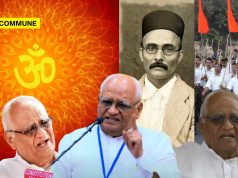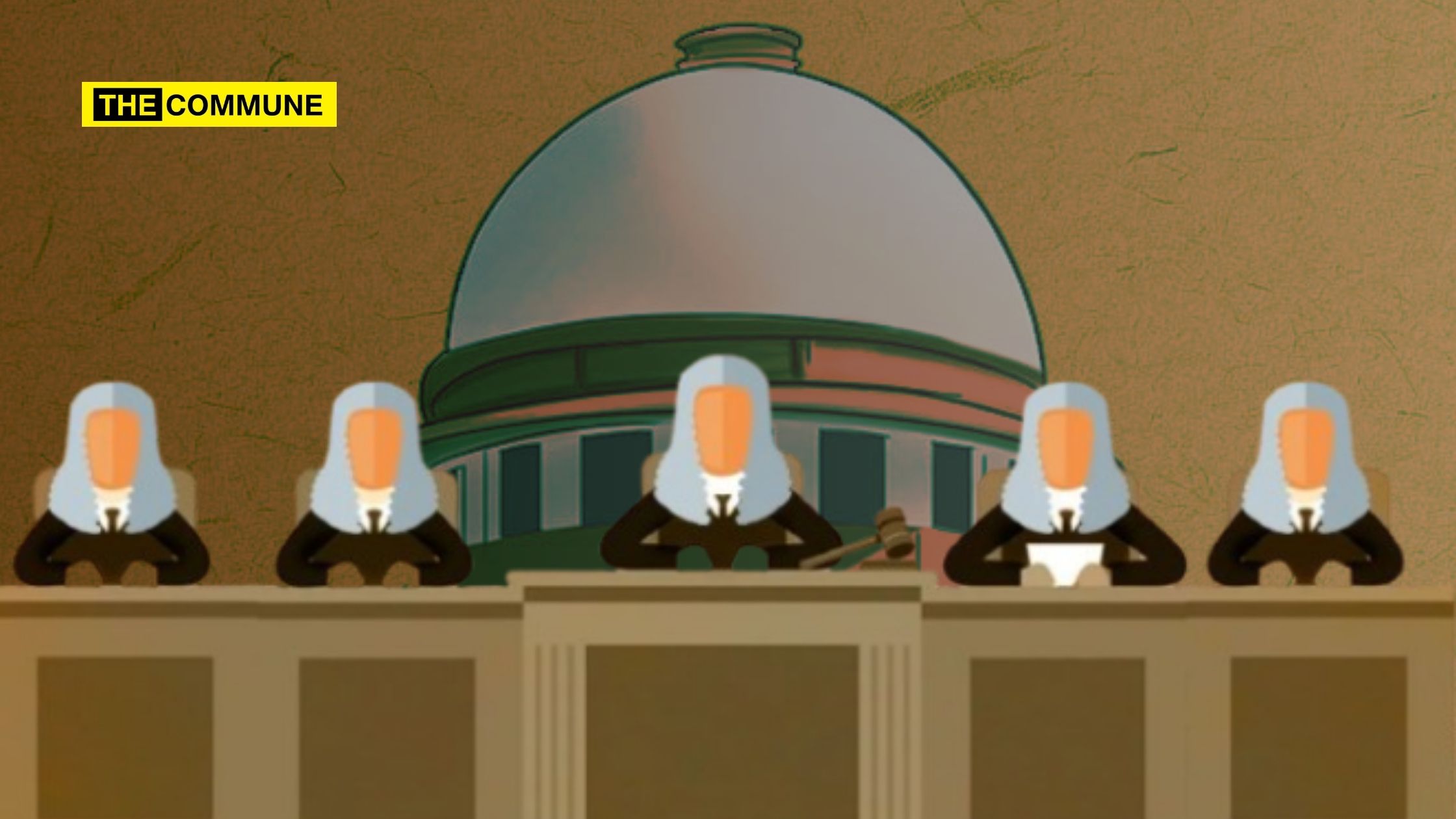
This is part two of the series titled: The Story.
To read part one, click here.
One of the most common claims made about Hinduism by Narrativewalas, who will constantly be seen plotting the overthrow of the leftist ecosystem—an event that is only spoken of in the future tense, never present—is this: Hinduism is the most tolerant religion in the world because Hinduism has no rules and nothing is considered ‘necessary’ in Hinduism. Along with this, a customary elaboration is given in a few sentences, which will include the token example of ‘Charvaka darshana’ (it is the favourite darshana of these clever folks because they think it lets them do whatever they want, live however they want, be essentially no different from the Westernized Indian urbanites and aspire to be like the West in all important matters and yet claim to be authentically Hindu and ‘culturally rooted’ folks rather than debauched hedonists). This claim is nonsense and those who make it, especially those who use the Charvaka Kavacha, are only folks who either don’t like knowing that they have strayed very far from their ancestral Hindu roots or are just too strongly lured by the lifestyle of the debauches (casual sex, drinking, parties, materialism, hyperindividualism, consumerism and so on). This is not rhetoric. It is meant literally. The claim actually is completely nonsensical.
Phantom Hinduism
The claim is that there are no rules or regulations, nothing you should particularly believe or practice and no constraints. In other words, there is no essential feature with or without which you gain or lose your Hinduness. In essence, there is no quality or feature that distinguishes a Hindu from a non-Hindu. Think of it this way. If a group has no rules, no terms and conditions for membership, no process of joining or leaving, no membership card, no obligations or privileges for a member and so on, what even is the group? Does the group exist? If the group had a name, say ‘Mayamrga’, what do I refer to when I say ‘Mayamrga’? What defines the group? How does one know if he is a member? How does one know when he has lost his membership? What quality or feature gives it its very existence? Forget knowing who the members are, we don’t even know what makes one a member. So far, the only thing we know is its name. Is that single feature enough to make a group exist as an entity? Did ‘Mayamrga’ started existing as soon as I gave the group a name? No.
The group needs a bit more substance to exist. For it to exist, there must be a way to know who and what is ‘inside’ and ‘outside’ the group. Without the boundary of a circle, there is no way to say what is inside and outside it on a piece of paper; the circle itself doesn’t exist anymore either. A house without walls is no house at all. It is only a bunch of furniture on open ground. Anybody can come and sit on the sofa, use the table and sleep on the bed. There is no piece of ground that can be marked off as within the ‘house’, so there is no question of ‘entering’ and ‘leaving’ it. The house does not exist. Hinduism as Narrativewalas describe it doesn’t exist either (or they’re just wrong). As we shall see, their ideas and opinions often leave one wondering what makes these folks right wingers at all. How did they come to the conclusion that they’re on the right? Maybe we will have an answer to that someday. For now, let’s stick to phantom Hinduism.
The fact that Narrativewalas need to resort to a claim that makes Hinduism non-existent just to show it is ‘inclusive’, the fact that they claim that their house has no walls just to show they’re friendly to guests (and this is when their home actually is the friendliest in the neighbourhood) shows the depth of their intellectual poverty. One wonders what they would’ve said if they belonged to one of the Abrahamic cults. The fact that these cults manage to convince many folks, even among Narrativewalas, that they are equally friendly, when they have repeatedly shown throughout history that they were and are the worst houses in the neighbourhood by as wide a margin as you can imagine, shows just how advanced they are at propaganda, how poor Narrativewalas are at it and why the Hindu Hriday Samrat of Narrativewalas is Mr Sabka Vishwas.
It is a liberal claim that Hinduism doesn’t exist, that there are just many religions in India and that ‘Hinduism’ is a fake entity created by colonists, which ‘Hindus’ use to maintain political majority and Brahmins use to appropriate local sampradayas and subjugate the non-Brahmins. It helps them divide the Hindu vote bank. But we know Hinduism exists. We see it around us every day and can point to things that are considered ‘Hindu’, things that Hindus consider Hindu. Moreover, Narrativewalas themselves don’t accept this conclusion and they know it is a liberal claim. They often accuse liberals of trying to balkanise the Hindu society into many smaller groups. But then, Narrativewalas can’t be wrong about Hinduism, can they? The standard response of Narrativewalas to any corrective effort directed at the RW ‘narrative’, even from within, is various shades of apathy, derision, indifference and accusation of being anti-right, or worse, of being ‘far right’ (it is believed that the term ‘far right’ denotes something negative and therefore anything the far right says is not worth listening to, although everything the far left—actually, there is only the left in Narrativewala discourse, no moderate or far left—says must be ‘countered’ and ‘debunked’ or dignified with a response in other ways).
The Mandala Model
Maybe it is worth seeing whether Hinduism can exist without Narrativewalas having to be wrong. Since we seemingly know who the ‘Hindus’ are and can point to things that are ‘Hindu’, Hinduism is not like Mayamrga; we know more than just its name. But how do we know that someone or something is ‘Hindu’ without knowing what makes someone or something ‘Hindu’? As long as we say Hinduism has no requirements, even if we accept that Hinduism has features, they won’t be essential features. You can be a Hindu even if none of them apply to you (just claim to be a Charvaka!). Since these features cannot decide membership, they are not bricks in the walls of Hinduism. There is still no Hinduism, no inside or outside. A few scenarios might illustrate this issue better.
Case 1. Let’s accept that there are many sampradayas and that they’re Hindu sampradayas despite what liberals say. There is ‘core’ Hinduism which does have requirements but there are other sampradayas which are quite loose and free yet somehow allied to core Hinduism. If that’s the case, then because of the concreteness of the core or ‘orthodox’ variety, Hinduism surely exists. But we’ve only pushed the boundary problem to the outer layers which, being loose, are still without a boundary. And since Hinduism surely exists, the lack of a boundary implies not that there is no Hinduism but that everything is Hinduism. Hinduism is digambara.
But if so, why all the conflict with Abrahamics? If everything is Hinduism, so is Abrahamism. Clearly, nobody is under this illusion. Narrativewalas even lament that the goodhearted Hindu who says Yeshu and Alla are also avataras is naive and ignorant and a threat to Hindu society’s survival, just as they criticise Gandhism. Moreover, lived experience tells us we can point to things that are Hindu. This by definition means we can also point to things that are non-Hindu because if everything is Hinduism, nothing would be particularly Hindu. The category and the term ‘Hinduism’ would be redundant. We would simply say ‘everything’ instead. Clearly, we are conscious of some kind of boundary.
We also don’t know what allies the outer layers to the core. We don’t know what keeps them within the Hindu fold without any of the requirements of the core. How can these outer layers be ‘outer layers’ at all when they don’t have any essential features in common with the core? Aren’t they just ‘outside’ instead? In fact, this scenario is familiar to us. This is something liberals and academics claim. They say that the ‘Vedic religion’ or ‘Brahmanism’ (the core) is different from ‘Hinduism’ (outer layers), which is a loose (which also means ‘friendly to Abrahamism’) bunch of traditions practiced by the common folk. And we know Narrativewalas do not accept this either.
Case 2. If we say that the outer layers also have boundaries, then Hinduism indeed has a boundary. The additional fact that we now internally acknowledge various sampradayas doesn’t matter because it’s internal. Even if Hinduism is a group of sampradayas in a mandala-like arrangement, the mandalas do form a collective outer boundary. Each sampradaya may additionally have its own specific requirements. If you don’t belong to any Hindu sampradaya, then you don’t belong to Hinduism. And since every sampradaya has requirements, so does Hinduism, much like Abrahamism. Academics too insist that Hinduism is structurally similar enough to Abrahamism to be studied under the same category of ‘religion’ (a category internal to Abrahamism) and they’re not different kinds of traditions. Alternatively, this is also how liberals describe Hindutva as opposed to Hinduism.
Case 3. Let’s say there is gradation in ‘Hinduness’. Outside of ‘core’ Hinduism, you have a gradient. Your practices and traditions move away from the ‘core’ little by little until you’re no longer recognisably Hindu. This seems to give Hinduism structure without requiring too much rigidity. By its very nature though, this gradient favours the core. For those interested in retaining a Hindu identity, there is incentive to be as much a ‘practicing Hindu’ (that too, practicing ‘core’ Hinduism) as possible because that makes your Hinduness least doubtful. And the more you deviate from the core, the less Hindu you become. Now if you want nothing to do with the gods and are an atheist (whatever that means), you don’t really follow any customs and traditions, you drink and party and live the aspirational lifestyle of the ‘modern’ Indian urbanite, you’re pretty far from the core on the gradient. You have very little in common with what is considered definitely Hindu. Charvaka Kavacha cannot protect your Hinduness here. And academics claim this also, that non-Brahmin communities have to ‘Sanskritise’ their culture in order to be accepted by tradition.
Case 4. Finally, let’s consider a dynamic scenario to account for how traditions change over time (Narrativewalas often implicitly accept the Christian notion of history-as-social-progress so maybe they’d prefer the word ‘evolve’ instead of ‘change’). Say there is a ‘present’ Hinduism consisting of many sampradayas. Say some Hindus have certain non-traditional practices and philosophies. These new elements spend some time, say a century, in a kind of ‘buffer zone’. Over this period, they coalesce into traditions of their own, Hindus see these elements appear regularly in Hindu contexts and learn to recognise them as elements of Hinduism, as Hindu traditions. Can anyone seriously say that if a bunch of Indians strictly follow a lifestyle of drinking, partying and sex and profess atheism for long enough, their practices will eventually be recognised as a new Hindu tradition just because they keep calling it ‘Charvaka’?
Clearly, even cultural dynamics can’t admit anything you want into Hinduism, even if you claim so in the name of ‘social progress’. Moreover, for this process to work, Hindus have to regularly see these elements appear in Hindu contexts and associate them with the practice of Hinduism. In other words, only ‘practicing Hindus’ can create new traditions. Obviously, the ‘modern’ Indian urbanite who professes atheism and never practiced anything doesn’t qualify. This is why Ramakrishna Paramahamsa is seen as a Hindu saint-philosopher by many, while Ram Mohan Roy, even though he lived earlier and founded Brahmo Sabha, which later became Brahmo Samaj, is often considered a British stooge and a crypto-Unitarian outside of textbooks and Bhadraloka. He is buried in UK, not cremated. It’s simple. The lifestyle of the ‘modern’ Indian urbanite has no connection with tradition, the civilisation, the way we have lived and thought for centuries at all. It is just not a continuation of any of the threads of the civilisational heritage. On the other hand, it is definitely a continuation of many threads of Western heritage in both, thought and action.
The Problem
It seems then that you can’t really escape the conclusion that this claim is absolute nonsense. We are not a hippy civilisation, Hinduism is not a house without walls and it is not a free-for-all. These are just meaningless platitudes that don’t make sense but sound vaguely nice when you say them. Worse, it often leads to leftist or Abrahamic stances! There’s a reason for this: the claim is itself a leftist claim. It is liberals who say that Hinduism has no rules (and Hindutva wants to turn it into an Abrahamism by forging rules). Narrativewalas just use it to call Abrahamism rigid and intolerant by contrast. They’re so excited about dissing Abrahamism that they don’t stop to ask if the premise of the argument is itself purpose-built for making certain kinds of claims. It makes Hinduism into an empty category that can be filled by whoever however they want. Such a category is no category at all because it fails to categorise. And that is precisely the point. That is the purpose of the premise. Empty categories are the single most powerful weapon in propaganda. Write this down.
Just a few centuries ago, whenever they tried to convince the Hindu that Jesus is the one true god, missionaries would get this response: Maybe so; we won’t deny that he is that to you but we have our own gods. When there is no ‘mine’ (Hindu) and ‘yours’ (non-Hindu), the awareness of a belongingness is impaired and the Hindu is taught to think that Jesus is also an ‘avatara’ of some sort, the Hindu is disarmed. Christians then appropriate saffron and other civilisational symbols, mimic the imagery of Krishna to depict Jesus and the Hindu, being stripped of a sense of ownership of his own traditions, is incapable of realising that something’s not right. Zakirs and Zachariahs cherrypick and mistranslate Sanskrit verses to show that Hinduism also says the same thing as their proselytisation handbooks or that the stereotypical ‘shrewd priest’ has ‘sullied’ Hinduism with ‘fake’ practices. The Hindu, thinking that everything is Hinduism and Hinduism accepts everything, gladly entertains the tribalistic agenda of conversion. The ‘Hinduism accepts everything’ trope lulls the Hindu into thinking that conversion is just cross-pollination between various branches of a global family, and he forgets that this tribalistic practice is the severest form of an ‘us v/s them’ mentality: it is conquest by demographic subversion. In fact, the deliberate vagueness of this trope makes some Narrativewalas even defend the appointment of Christian babus to temple management boards like that of the Tirupati Devasthana under a Christian CM, all because ‘Hinduism doesn’t discriminate’! According to some Narrativewalas, just because I think the people of our neighbourhood should all live harmoniously without ‘discrimination’, I should let my neighbours manage the affairs of my own home!
Leftists use the trope because leftism/Marxism/communism has always been opposed by Hindus, not least because we consider it a foreign ideology incompatible with our civilisation. They want to damage the Hindu opposition by defaming it and winning some converts. So they argue that there is a rigid, ‘oppressive’ (the favourite word of leftism) Brahmanical tradition which has nothing to do with folk practices. Brahmins, in their infinite thirst for power and domination, appropriated folk traditions and assimilated them into a Brahmanical framework, thus ‘creating’ Hinduism, which privileges the Brahmins and subjugates other Indian communities and tribes. They somehow managed to successfully work towards the same goal without ever coming together and forming any church-like centralising organisation, which could channel their efforts or enforce any of this. Even with the entire state apparatus at hand, this stuff would be impossible to impose without a centralising source to dictate doctrine and practice. But regardless of the logistical impossibility, this story is recycled for each section of the society they target for conversion to leftism. Since the leftists hate the middle class (the bourgeoisie), the common folk who practice ‘Hinduism’ get the same treatment. Their traditions have already been appropriated by Brahmins and since now they defend Hinduism, they’re helping the oppressors continue their project of subjugation and are part of the problem. Thus they slice off sections of the civilisation away from the roots (Dalits, Adivasis, Buddhists etc.) and convert them to leftism.
Liberals use it to defend their degenerate lifestyles (yes, it is degenerate and this lifestyle is the root cause of the Bois’ and Girls’ Locker Room scandal). They also use it to make it look like they can still be tethered to the civilisation no matter how far away they stray. Once again, by blurring the boundaries between themselves and Hindu society, they seek to soften the impact of transitions so that conversion becomes easier. These Allied Forces also use each other’s arguments or use them together. But why do Narrativewalas?
Click here to read part 3.




